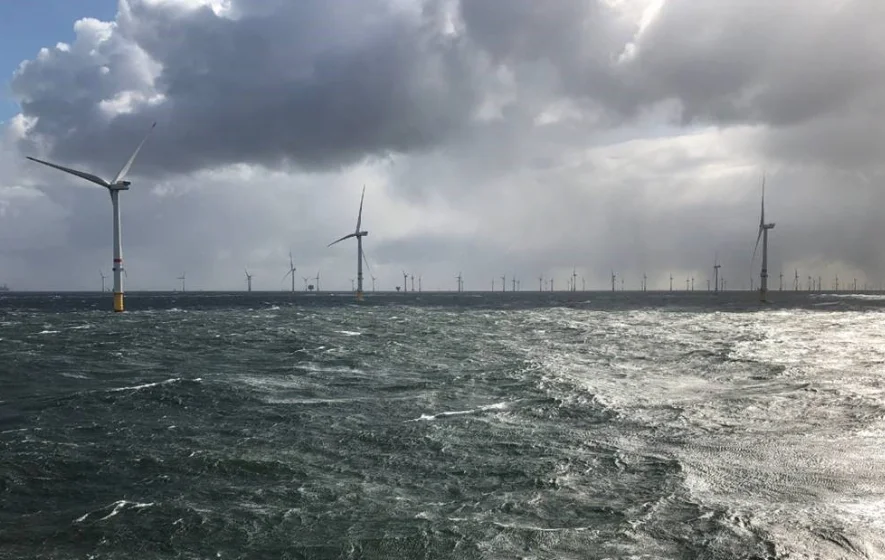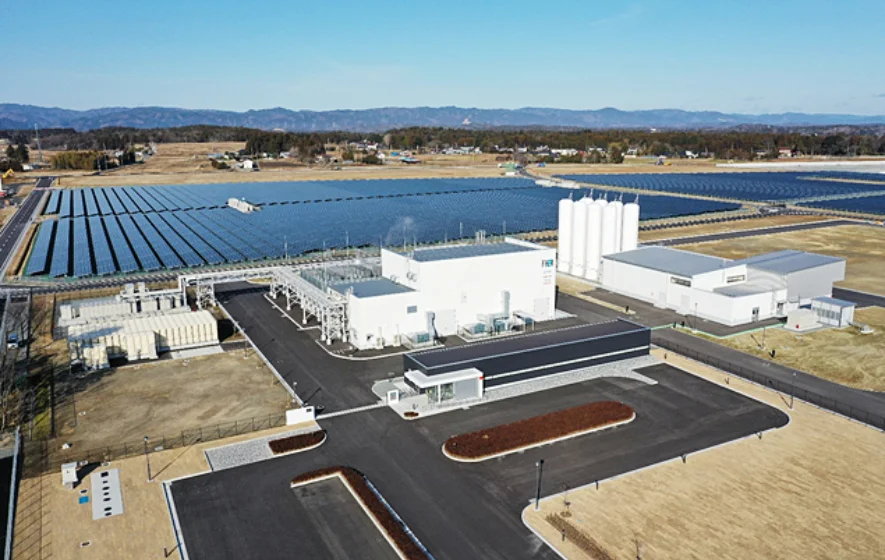Bigger, stronger, more efficient: the expansion of renewable energy is progressing around the globe. Boasting increasingly novel innovations, the installations that harness the energy of the wind, water and sun constantly trump each other in terms of scale. en:former presents a gallery of ten renewable record holders.
A solar farm as big as a city
Extending across 40 square kilometres, Bhadia Solar Park in the west of India towers over all others. The PV modules have a total capacity of 2,245 MW covering the equivalent of 5,600 soccer pitches – enough electricity to cover ten percent of the energy needs of the entire Indian state of Rajasthan of around 38,000 GWh. The farm, which was completed in March 2020, supplanted the previous incumbent, Pavagada Solar Park in the south Indian state of Karnataka, which has an installed capacity of up to 2,050 MW. Europe’s largest solar energy facility is located in the southwest of Spain. Nunez de Balboa Solar Farm in the Extremadura region also went online in 2020. It consists of 1,430,000 PV modules on ten square kilometres with a total capacity of 500 MW.
The highest wind turbine is located near Stuttgart
Extending 246.5 metres into the sky, one wind turbine, erected in the Limpurg mountains in Gaildorf near Stuttgart, towers above all others. This XXL wind turbine, built by Max Bögl Wind AG, is part of a GE wind farm that has been operating since 2018.
Its record height comes courtesy of a sophisticated system that combines wind energy with a pumped-storage power station, with a water reservoir located in the tower’s foundation. It stabilises the wind turbine and is connected to a hydroelectric power plant via pipes.
Even more giant wind turbines are to start turning in Sweden from 2021.
XL wind farms off the coast of England
Europe is home to all of the world’s Big Ten offshore wind farms. Boasting an installed capacity of 659 MW, Walney Extension in the Irish Sea off the north-western coast of England has been atop the list since September 2018. The 87 turbines are distributed between the seven and eight megawatt classes (47 and 40). This makes for nearly 30 MW more than the previous record holder, the London Array wind farm (photo 1) operated by RWE off the Kent coast in the outer Thames Estuary. In terms of wind turbine numbers, however, London Array remains the front-runner, with a whopping 175 rotors spinning away. Together with Gwynt y Mor (photo 2) it is the biggest renewables asset with RWE involvement – London Array has an overall capacity of 630 MW and generates enough clean electricity to power around 500,000 British homes, while displacing around 900,000 tons of CO2 a year.
RWE also operates Gwynt y Mor with a capacity of 576 MW. The wind farm located off the coast of North Wales consists of 160 turbines in total and can power 30% of all homes in Wales. In addition, RWE is currently constructing another wind farm, which will be one of the largest ones worldwide: Triton Knoll with a capacity of 857 MW. It is planned to go into operation in 2022. The North Sea is prime real estate for offshore wind farms. The installed capacity of the farms located in the German areas of those waters alone totals some 7,350 MW.
More on offshore wind extensions in UK.
Electricity from a warehouse roof
With a size equalling six soccer fields, the world’s largest roof-mounted solar array extends over 45,000 square metres. The 20,000 PV modules are installed on the roof of a distribution centre of discounter Aldi in Perlen, Switzerland. The array is more than a thousand times the size of an average solar system on a residential rooftop and has a maximum capacity of 6,460 kilowatts. Every year, Aldi produces enough electricity to serve 2,150 two-person households.
A reservoir as long as Germany
Flowing along 6,380 kilometres within China, the Yangtze River is the longest river in Asia and third-longest in the world, only trailing the Nile and Amazon. From its source in the Tibetan Highlands to its estuary in the China Sea, it has a height differential of more than 4,400 meters. This drop unleashes gargantuan forces. To make efficient use of the energy produced by the masses of water, the Chinese government commissioned the construction of a huge dam at Sandouping in Hubei Province. A concrete wall with a length of 2.3 kilometres and a height of up to 185 metres dams up nearly 40 cubic kilometres if water in a reservoir extending 663 kilometres through three gorges, fittingly called the Three Gorges Dam. This equals the distance from Hamburg to Munich. The drop created by the dam is used to harness energy. The water drives turbines capable of generating up to 22.5 gigawatts of electricity – roughly as much as 22 nuclear power stations.
The most powerful tidal power station
The region remains Asia and the technology hydroelectric power. Sihwa-ho Tidal Power Station in Asan Bay in the Yellow Sea has been generating electricity since 2011 by taking advantage of the tidal range, the technical term designating the difference in water level between high and low tide. The tidal range is especially wide between the Korean Peninsula and China, totalling up to eight metres in Sea Turtle Tidal Park, an artificial lagoon. With an output of 254 MW, the ten turbines of the South Korean power station produce slightly more electricity than the world’s second-largest tidal power plant, which is located on the estuary of the Rance River in France (capacity: 240 MW).
Hundreds of thousands of wood pellets
Located in the south of Poland, Polabiec Power Station uses wood chips and agricultural waste to produce electricity. With a net capacity of 205 MW, the biomass-fired facility is the most powerful of its kind. Up to 890,000 wood pellets and 220,000 metric tons of agricultural by-products, e.g. cultivation left-overs like straw, have been burned every year to fire the power plant since November 2012. The biomass weighs roughly as much as 110 Eifel Towers.
More on this topic: Opting for biomass in power plants for a sustainable power supply.
Power turbine with helicopter pad
Besides being tall – a full 220 metres – it is also extremely powerful. With a maximum capacity of 9.5 MW, the MHI Vestas V164-9.5 MW turbine is currently the world’s highest-output offshore wind turbine. Generating up to 45 GW of electricity a year, it is capable of supplying 15,000 homes with electricity. One of the Danish manufacturer’s facility’s highlights is the helicopter pad.
One of the envisaged deployments is the UK Triton Knoll wind farm currently being built by RWE. A total of 90 of the power turbines are scheduled to go online off the coast of Lincolnshire by 2022. The wind farm’s official maximum rating is 885 MW.
Grid stability thanks to mammoth battery
A whopping 252 containers full of batteries occupying a space as big as two soccer pitches: the world’s largest battery storage system. It was built in Buzen on the Japanese Island of Kyushu. The lithium-sulphur batteries from Mitsubishi Electric can store up to 300 MWh of electricity and have an output of 50 MW. They serve to stabilise the grid and are capable of offsetting fluctuations caused by renewable energy.
Tons of green hydrogen
Green hydrogen is a pivotal element of the energy transition. It can be used not only to store energy, but also as fuel, e.g. for cars. Green hydrogen has been in large-scale production since March 2020. Asahi Kasai has built the world’s largest alkaline hydrogen electrolyser in Namie in Fukushima Prefecture as part of a development project initiated by the Japanese New Energy and Industrial Technology Development Organization.
Dubbed the ‘aqualyzer,’ it has a capacity of 10 MW. this means that it produces some 100 kilogrammes of hydrogen per hour in normal operating mode. By comparison, a fuel cell car consumes about a kilogramme of hydrogen every 100 kilometres. The electricity used by the aqualyzer to produce hydrogen is mainly solar power. PV modules with a maximum capacity of 20 MW have been installed on the premises for this purpose. The facility is also powered from the grid.
How the hydrogen supply in Europe could look like in the future.
Photo credit: Shutterstock



















